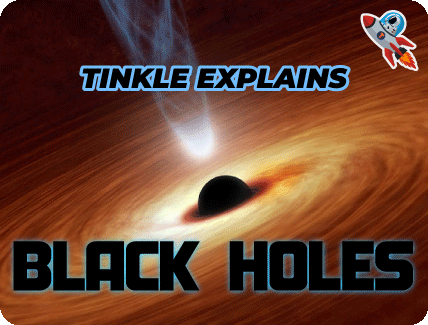

















One day, Mynah was on the way back from school with her friend Sheila. They were discussing black holes for their upcoming Space Week assignment. Let’s find out more!
When something goes beyond a certain region around the black hole, called the event horizon, the only way to escape is to be faster than light. However, nothing in the known universe is faster than light! Since even light cannot escape black holes, they are not visible.
One way to understand the effect of black holes is through Albert Einstein’s general theory of relativity. Imagine space as made out of a taut fabric. This fabric’s components are space and time. If something heavy were placed on this taut fabric, it would curve the cloth around it. So, something that has strong gravity will bend space and time. Black holes, having very strong gravity, would cause a lot of such bending, causing light and other things in space to fall in if they get close enough.
There are also black holes that are medium in size, with a mass about 20 times that of the Sun. These are called stellar black holes.
Black holes that have more mass than a million Suns are called supermassive black holes!
Black holes, as you may have understood from the atom-sized ones, are very dense; this means that they have a lot of matter condensed into a comparatively much smaller space!
Stars like our Sun have limited lives. Like humans and animals, they are born, have a life and then die. When they run out of the fuel that makes them burn, their cores become too heavy for them and they collapse inwards (implode). The outward parts of the stars, in turn, explode. This event is called a supernova. The collapsing core of the star eventually ends up as a point with no volume and infinite density. This means that this part virtually occupies no space but has a very high mass. This point is called the singularity of the black hole.
Apart from a supernova, there are other ways in which black holes are formed as well.
Due to their strong gravity, black holes have effects on the celestial objects around them, such as stars. Through these effects, we are able to detect their presence. The behaviour of these objects can be seen using special telescopes designed for the purpose.
There is also an observatory called LIGO (Laser Interferometer Gravitational-Wave Observatory) that picks up on the gravitational waves that black holes create in space-time, and amplifies these enough so we can hear how they sound! Through calculations, the size and mass of the source is identified, and they are thus categorized as different objects, including black holes.
A powerful radio telescope like the Event Horizon Telescope (EHT) can even photograph black holes, or more precisely, the gas that orbits them. In 2019, it released an image of M87*, the black hole at the centre of the Messier 87 galaxy. Its mass is 6.5 billion times that of the Sun!
Recently, a black hole much nearer to us was also photographed by the EHT!
Theoretically, there is a black hole at the centre of every galaxy, that too a supermassive one. Even our galaxy, the Milky Way, has a supermassive black hole at the centre, called Sagittarius A* or Sgr A* for short. After a lot of difficulty in photographing it, the EHT succeeded in doing so.
Like Mynah and Sheila, we hope you enjoyed learning about this enigmatic part of space too!
Click here to learn about Supernova